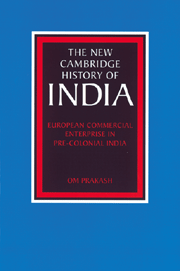Book contents
- Frontmatter
- Dedication
- Contents
- List of figures
- List of maps
- List of tables
- General editor's preface
- Preface
- Introduction
- 1 India in the Indian Ocean trade, circa 1500
- 2 The Portuguese in India, 1500–1640
- 3 The European trading companies: exports from Europe and the generation of purchasing power in Asia
- 4 The companies in India: the politics and the economics of trade
- 5 Euro-Asian and intra-Asian trade: the phase of Dutch domination, 1600–1680
- 6 The VOC and the growing competition by the English and the French, 1680–1740
- 7 The supremacy of the English East India Company, 1740–1800
- 8 European trade and the Indian economy
- 9 Conclusion
- Bibliographic Essay
- Index
- Misc-endmatter
- Map 1 Important trading centres in Asia in the seventeenth and eighteenth centuries"
- Map 2 Portuguese seaborne empire, c. 1580"
- Map 3 The Indian Ocean in the seventeenth and eighteenth centuries, showing the settlements of the English East India Company and of other European nations"
- Map 4 India: main textile–weaving areas, 1600–1750"
- References
5 - Euro-Asian and intra-Asian trade: the phase of Dutch domination, 1600–1680
Published online by Cambridge University Press: 28 March 2008
- Frontmatter
- Dedication
- Contents
- List of figures
- List of maps
- List of tables
- General editor's preface
- Preface
- Introduction
- 1 India in the Indian Ocean trade, circa 1500
- 2 The Portuguese in India, 1500–1640
- 3 The European trading companies: exports from Europe and the generation of purchasing power in Asia
- 4 The companies in India: the politics and the economics of trade
- 5 Euro-Asian and intra-Asian trade: the phase of Dutch domination, 1600–1680
- 6 The VOC and the growing competition by the English and the French, 1680–1740
- 7 The supremacy of the English East India Company, 1740–1800
- 8 European trade and the Indian economy
- 9 Conclusion
- Bibliographic Essay
- Index
- Misc-endmatter
- Map 1 Important trading centres in Asia in the seventeenth and eighteenth centuries"
- Map 2 Portuguese seaborne empire, c. 1580"
- Map 3 The Indian Ocean in the seventeenth and eighteenth centuries, showing the settlements of the English East India Company and of other European nations"
- Map 4 India: main textile–weaving areas, 1600–1750"
- References
Summary
THE DUTCH COMPANY TRADE
The Coromandel coast
We noted earlier that the first Indian region to be reached by the Dutch East India Company was the Coromandel coast where a factory was established as early as 1606. While the region had the potential of providing items such as indigo, saltpetre and diamonds for the European market, its principal attraction consisted in the availability of large quantities of textiles initially primarily for southeast Asia, but eventually also for the European market. The staple varieties included the ‘long cloth’, dyed in bright colours and with stripes and checks, and re-exported extensively by the Dutch from Europe to the West Indies under the title of ‘Guinea linen’. A variant, bleached white or dyed blue, was also extensively used in the southeast Asian trade under the designation of ‘negro-cloth’. Other staple varieties exported to Europe included bethilles, salampuris, muris and parcallas. The range of the varieties exported to the Asian markets was much larger. The principal consuming markets served by the Dutch were in southeast Asia and included the Spice Islands (the Moluccas, Banda and Celebes), Java, Sumatra, the Malay peninsula, Siam and Burma. In the Far East, limited quantities of Coromandel textiles figured in the exports to Taiwan and Japan. Other Asian markets supplied with these textiles were Sri Lanka and Persia. In Indonesia, these textiles were used primarily to procure pepper and other spices, but were often also used as a medium of payment to the soldiers in the service of the Company.
Keywords
- Type
- Chapter
- Information
- European Commercial Enterprise in Pre-Colonial India , pp. 175 - 210Publisher: Cambridge University PressPrint publication year: 1998
References
- 1
- Cited by



